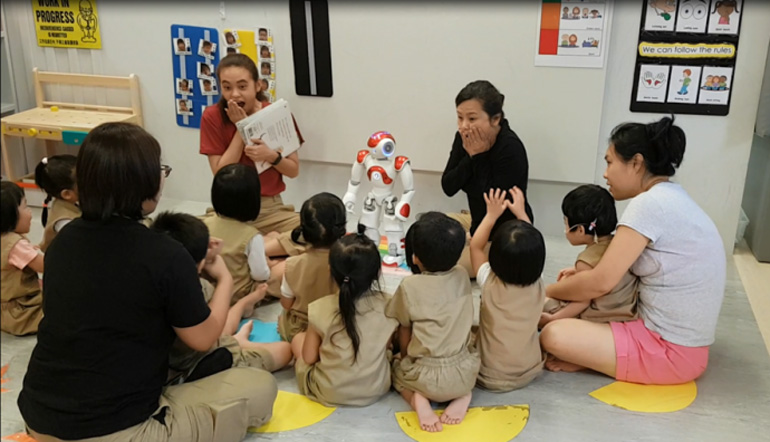
Pre-schoolers are not known for their patience. They’d love to do anything but sit and listen to a teacher: play, run about, and chat loudly. If the class included children with additional needs, teachers would require even more attention to handle the class.
The team at Kindle Garden, Singapore’s first inclusive preschool, got together with SG Enable to study this classroom problem: Is there anything more that can be done to engage children’s attention during class?
How about a robot?
Enter Nao, the robot storyteller
Recent studies have found that robots can help improve children’s behaviour in a classroom context. There have even been studies suggesting that robots could benefit children with autism in a one-on-one setting. Bearing these trends in mind, the project team began to explore using Nao, the programmable humanoid robot, as a teaching aid in the classroom.

The NAO robot from Softbank Robotics (Xavier Caré / Wikimedia Commons / CC-BY-SA)
Nao (pronounced Nah-oh) isn’t just a robot that can be programmed to do exactly what the operator tells it to. It can make sense of its environment through its sensors; it can walk, sit and lie down; and it can converse with humans through its microphones and speakers.
The team began work on Nao to help with one of the most popular classroom activities at Kindle Garden: Storytelling.
The experiment
To make the experiment interesting. the school staff worked with SG Enable to shortlist two storybooks for Nao to read: “On the Bear Hunt” and “Goodnight Gorilla”, because they offered numerous opportunities for dramatisatopn through sound effects. The SG Enable team programmed into Nao various sounds described in the book, such as such as “banging the door shut” and “running down the stairs”.
After it had been programmed, Nao was introduced into the regular storytelling sessions at Kindle Garden over several days. Each story was presented multiple times with slight variations: simple narration without the robot; narration with sound effects from Nao; and narration with Nao’s sounds while teachers helped the children act out the scenes. Scores were assigned to the observed behaviour of children with additional needs—including when they were distracted from the story, whether they could be re-directed to the activity.
The kids love the robot (how could they not?)
Like all experiments, adjustments had to be made along the way. In initial sessions, Nao spoke too fast for the children and had to be slowed down. In later rounds of storytelling, Nao did not respond quickly enough to the children, causing them to lose interest and drift away.
Overall, however, the presence of Nao had a positive effect on the children: They listened attentively and were awed by Nao’s gestures and sound effects. Teachers found the children “very excited and attentive”.
Even the children with additional needs focused well: In one particular session, project team members observed the face of one child, who had cerebral palsy, light up in response to Nao’s actions.
At the end of each experiment, the children were quite reluctant to have Nao leave the class, and looked forward to have the robot back in their midst.
Nao performing at the 398.2 Storytelling Festival, 1 Sep 2017
The experiment may have been a modest one, but the team was encouraged by the result. “When I saw how Nao was able to keep additional needs children engaged,” said Mr Chan Chee Keong, project lead for the storytelling project, “it reassured me that assistive technology will play an important role in helping additional needs children live independent lives.”
Who knows: If tweaked right, we could be seeing robot storytellers in preschools all over Singapore.